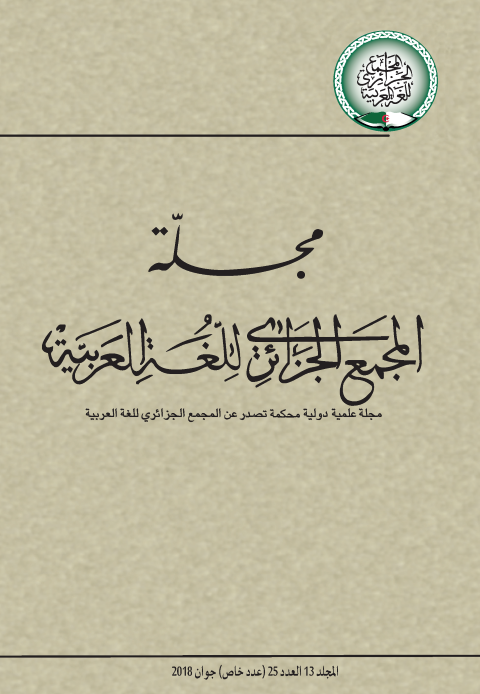The Notion of Syllable and the Cinetico-Impulsional Theory of the Arab Phoneticians
Keywords:
the cinetico-impulsional theory, syllable, Hadj-SalahAbstract
The syllable, as viewed by the ancient Greek, was known by the Arabs through translations of ancient studies. But much prior to this contact between Greek and Arab thought, a conception of speech dynamics already existed; it was thoroughly original, and based on the concepts of << harf » and « haraka ». Harf is the minimal segment of the speech continuum. Al Khalil (8th century) ascertains that it has two qualities: sound colour (gars) and strength of motion (sarf). The latter word is explained by the word << haraka ». According to many authors, it is the acoustico-physiological motion which is re- quired both for sequentially producing harf and for gliding to the following articulation. Confirmation is given by rhythm conceived by Arabs musicologs and metricists. They have retained «sabab»> as the smallest articular molecule; however sabab bears the meaning of «<long syllable». In fact, a normally uttered speech sequence does not contain syllabic divisions, as is shown by instrumental observa- tion, and the only item which may be presented as a syllable is the speech sequence. It can actually be isolated, that is to say that which may be limited between two «< sukuns » (opposite to «< haraka »).
The author brings forward the idea of translating «<haraka» by <<kinem»>, the state of a speech segment endowed with haraka, by <<<kinesis>>, and its opposite by «<akinesis». The concept expressed by the words <<kineised» and «<akineised» seem to him more adequate than the Saussurian concepts: << explosive » and «<implosive».
Downloads
References
ابن جني، أبو الفتح. الخصائص. القاهرة، 5 أجزاء، 1317-1321هـ. تحقيق علي النجار.
Ibn Jinnī, Abū al-Fatḥ. al-Khaṣāʼiṣ. al-Qāhirah, 5 ajzāʼ, 1317-1321h. taḥqīq ʻAlī al-Najjār.
ابن جني. سر صناعة الإعراب. جزء 1.
Ibn Jinnī. Sirr ṣināʻat al-iʻrāb. Juzʼ 1.
ابن جني. المنصف. جزء 1 و2.
Ibn Jinnī. al-Munṣif. Juzʼ 1 wa-2.
ابن حزم، علي بن أحمد. الفصل في الملل والأهواء والنحل. القاهرة، 5 أجزاء، 1317-1321هـ.
Ibn Ḥazm, ʻAlī ibn Aḥmad. al-faṣl fī al-milal wālʼhwāʼ wa-al-niḥal. al-Qāhirah, 5 ajzāʼ, 1317-1321h.
ابن رشد. تلخيص كتاب الشعر. تحقيق عبد الرحمن بدوي، القاهرة، 1953.
Ibn Rushd. Talkhīṣ Kitāb al-shiʻr. taḥqīq ʻAbd al-Raḥmān Badawī, al-Qāhirah, 1953.
ابن سينا. الشفاء، جزء 3 جوامع علم الموسيقى. القاهرة، 1965.
Ibn Sīnā. al-Shifāʼ, Juzʼ 3 Jawāmiʻ ʻilm al-mūsīqá. al-Qāhirah, 1965.
ابن يعيش. شرح المفصل. جزء 9.
Ibn Yaʻīsh. sharḥ al-Mufaṣṣal. Juzʼ 9.
أبو عمرو الداني. التحديد في الإتقان والتجويد. مخطوط رقم 23، جار الله - إسطنبول.
Abū ʻAmr al-Dānī. al-Taḥdīd fī al-Itqān wa-al-tajwīd. makhṭūṭ raqm 23, Jār Allāh-Isṭanbūl.
أرسطو. فن الشعر. ترجمة J. Hardy، باريس، 1932.
Arisṭū. Fann al-shiʻr. tarjamat J. Hardy, Bārīs, 1932.
البلاوي. كتاب ألف باء. القاهرة، 1870.
alblāwy. Kitāb alf Bāʼ. al-Qāhirah, 1870.
الجرجاني الشريف. شرح المواقف. جزء 5.
al-Jurjānī al-Sharīf. sharḥ al-mawāqif. Juzʼ 5.
الرازي، فخر الدين. التفسير الكبير. القاهرة، 30 جزء، المطبعة الباهية. جزء 1.
al-Rāzī, Fakhr al-Dīn. al-tafsīr al-kabīr. al-Qāhirah, 30 Juzʼ, al-Maṭbaʻah albāhyh. Juzʼ 1.
الرماني، علي بن عيسى. شرح كتاب سيبويه. الجزء 5، معهد المخطوطات العربية، الجامعة العربية.
al-Rummānī, ʻAlī ibn ʻĪsá. sharḥ Kitāb Sībawayh. al-juzʼ 5, Maʻhad al-Makhṭūṭāt al-ʻArabīyah, al-Jāmiʻah al-ʻArabīyah.
الزجاجي. إيضاح علل النحو. القاهرة، 1959.
al-Zajjājī. Īḍāḥ ʻIlal al-naḥw. al-Qāhirah, 1959.
سيبويه. الكتاب. تحقيق وشرح عبد السلام محمد هارون، الجزء 4، عالم الكتب، ط3، بيروت، 1983.
Sībawayh. al-Kitāb. taḥqīq wa-sharḥ ʻAbd al-Salām Muḥammad Hārūn, al-juzʼ 4, ʻĀlam al-Kutub, ṭ3, Bayrūt, 1983.
السيوطي. الأشباه والنظائر. حيدر آباد، ط1، 1317هـ.
al-Suyūṭī. al-Ashbāh wa-al-naẓāʼir. Ḥaydar Ābād, Ṭ1, 1317h.
الفارابي. كتاب الموسيقى الكبير. مخطوط رقم 430، الفنون الجميلة، المكتبة الوطنية، القاهرة.
al-Fārābī. Kitāb al-mūsīqá al-kabīr. makhṭūṭ raqm 430, al-Funūn al-jamīlah, al-Maktabah al-Waṭanīyah, al-Qāhirah.
القاضي عبد الجبار. المغني. جزء 7.
al-Qāḍī ʻAbd al-Jabbār. al-Mughnī. Juzʼ 7.
المبرد. المقتضب. القاهرة، 1386هـ. جزء 1.
al-Mibrad. al-Muqtaḍab. al-Qāhirah, 1386h. Juzʼ 1.
مكي حموش. الرعاية. مخطوط رقم 672، أوقاف المكتبة العامة - الرباط.
Makkī Ḥammūsh. al-Riʻāyah. makhṭūṭ raqm 672, Awqāf al-Maktabah al-ʻĀmmah-al-Rabāṭ.
Bravnan. Materialen und untersuchungen zu den phonetischen lebren der Araber. Gottingen, 1934.
Chlumsky. Archives néerlandaises de phonétique expérimentale, XI, 1935.
De Saussure, Ferdinand. Cours de linguistique générale. 1966.
Draper, M., Ladefoged, P., Whitteridge, D. Syllables and Stress. In Miscellanea Phonetica, 3, 1958.
Durand, M. Voyelles longues et voyelles brèves. Paris, 1946.
Erlanger, R. d'. La musique arabe. Paris, 1938. t2.
Fleisch, Henri. La conception phonétique des Arabes d'après le Sirr Sinaat al-l'arab d'Ibn Ginni.
Hala, B. La syllabe, sa nature et son origine. ORBIS, 1961.
Ladefoged, P. Three Areas of Experimental Phonetics. Londres.
Lebrun, Y. Is stress essentially a thoracic or an Abdominal pulse? In Linguistic Research in Belgium. Wetteren, 1966.
Le monde oriental. Uppsala, vol 14, 1920.
Pancocelli-Galzia, G. Die experimentelle Phonetik in ihrer anwendung auf die sprachwissenchaft. Berlin, 1924.
Pines, S. Sur la théorie de l'impétus. Archéion, 1938.
Steinthal. Geschichte der sprachwissenchaft. Berlin, 1890. 1.
Stetson. Motor Phonetics. 2nd Ed, Amsterdam, 1951.







